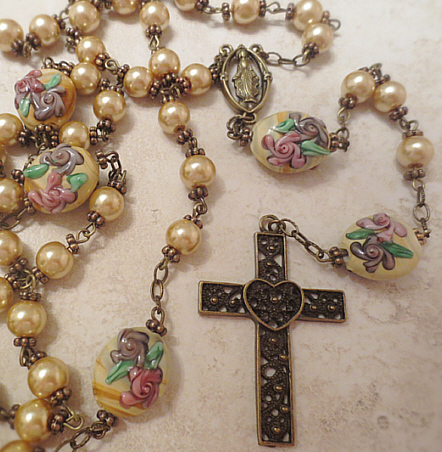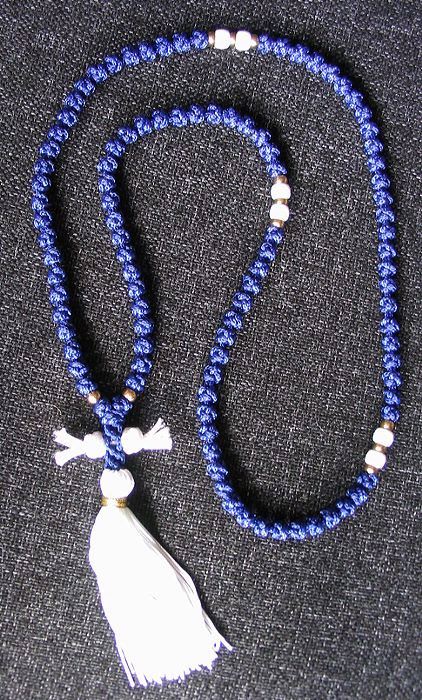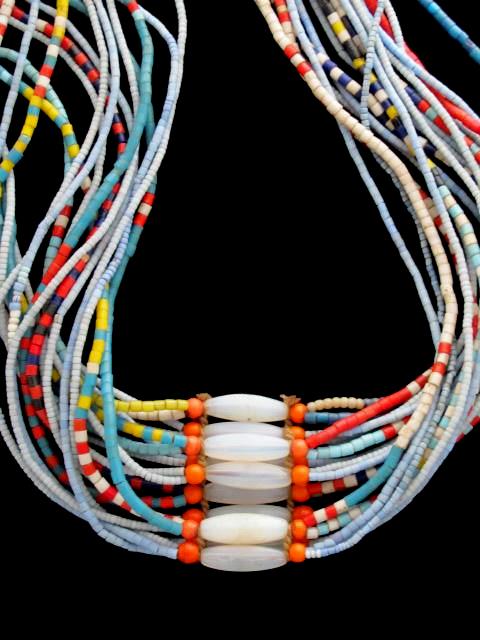 Submitted by Lady Orleans - ... on
Submitted by Lady Orleans - ... on

Prayer beads are used by members of various religious traditions to mark the repetitions of prayers, chants or devotions. Beads are among the earliest human ornaments and ostrich shell beads in Africa date to 10,000 BC.Over the centuries various cultures have made beads from a variety of materials from stone and shells to clay.
The English word bead derives from the Old English noun bede which means a prayer. The exact origins of prayer beads remain uncertain, but their earliest use probably traces to Hindu prayers in India. Buddhism probably borrowed the concept from Hinduism.
Prayer Beads and Knots from around the world
Sha sha – The first beads were grooved pebbles, bones, and teeth made over 40,000 years ago and had talismanic and symbolic meaning. “Sha” is the Egyptian word for luck. These beads were used as a way to pray or divine by casting them on the ground or wearing them for good luck. Divination was man’s earliest way to communicate with spirit. Stones, beads, sticks, shells, leaves, metal coins etc…were all used as tools for divination. Eventually divination gave way to prayer beads or talismens that people could wear and carry with them.
Japa-mala – Means “muttering chaplet,” which refers to a prayer beads function as a means of recording the number of prayers said. In addition to helping keep one’s place in structured prayers, prayer beads also symbolized the commitment to a spiritual life. With their circular form, a string represents the interconnectedness of all who pray.
Mala – Buddhists and Hindus use 108 beads divided into four sections of 27 by three resting beads. The mala is used for counting mantras, chants or prayers. Preferred woods are sandalwood or sacred wood from the Bodhi tree. The Meru is a larger bead, not part of the 108. It is not tied in the sequence of the other beads. It is the guiding bead, the one that marks the beginning and end of the mala. It also stands for the wisdom that comes with emptiness. Mala means “rose” or “garland” in Sanskrit. The earliest known mala is around two thousand years old.
Shiva Malas have beads made from rudraksha (Shiva’s eyes). Vishnu Malas usually use beads made from the tulsi (Holy Basil) The 108 beads represented the cosmos, in which people multiplied the sum of the twelve astrological signs by the nine planets.
Twenty-seven-bead smaller wrist malas were created to prevent the prayer beads from touching the ground during prostrations.
In Tibet, malas of inlaid bone originally included the skeleton parts of holy men, to remind their users to live lives worthy of the next level of enlightenment. Today’s bone malas are made of yak bone, which is sometimes inlaid with turquoise and coral. The 108 beads represent the number of worldly desires or negative emotions that must be overcome before attaining nirvana.
Baha’i – consist of either 95 beads or 19 beads strung with the addition of five beads below.
Chinese Su-chu – Chinese Buddhists and Taoists use a 108-beads, which has three dividing beads, so the su-chu is divided into three parts of 36 each.
Jewish Tallit – Jewish Prayer shawls are made of wool and linen or silk with fringe all around its rectangular shape. Five knots that create four tassels called tzizit are attached to the four corners of the shawl.
The tallit indicates obedience to a passage in Numbers 15:37-41. “Speak unto the children of Israel, and bid them that they make them fringes in the borders of their garments throughout their generations, and that they put upon the fringe of the borders a ribbon of blue: And it shall be unto you for a fringe, that ye may look upon it, and remember all the commandments of the LORD, and do them; and that ye seek not after your own heart and your own eyes, after which ye use to go a whoring: That ye may remember, and do all my commandments, and be holy unto your God.”

http://www.infinitelyspiritual.com/Christian.html
Catholic Rosary – The person widely believed to have introduced prayer beads is Saint Dominic, after he had a visitation by the Blessed Virgin Mary. And Thomas of Contimpre first called them a rosary, form the word rosarium or “rose garden,” since the faithful used strung rose petals and beads made of crushed rose petals to count prayers. A rosary is divided into groups of 10 beads, called decades, a Catholic repeats the “Our Father” and “Hail Mary” prayers as he or she marks off the beads with the fingers while meditating on the life of Jesus and Mary.
Roman Catholic rosaries have 150 beads, the same number of psalms in the Bible. In the twelfth century, religious orders recited together the 150 Psalms as a way to mark the hours of the day and the days of the week. Those people who didn’t know how to read wanted to share in this practice, so praying on a string of 150 beads or knots began as a parallel to praying the psalms. It was a way that the illiterate could remember the Lord and his mother throughout the day.

"Komboskini" by Theona
Eastern Orthodox – use knots and beads. Shorter knotted ropes are worn on the wrist. Often made of wool, the Greek prayer ropes – called kombologion have 33, 50, or 100 knots. Russian chotki have 33, 100, or 500 knots. Sometimes the faithful use bead strands resembling a ladder (each end of a bead touching two parallel strands), which signifies the soul making its ascent to heaven.
Islamic Tasbih/Masbaha/Subha – Islamic Prayer Beads consist of 99 or 33 beads. During the Prophet’s time, date stones, olive seeds and pebbles were used to make tasbish beads. Muslims use strings of 33 or 99 beads with one “leader” bead, which represents the 99 names of Allah found in the Koran and the one essential name.
Muslim prayer beads include markers after the 33rd and 66th beads representing the word “praise”. Masbaha or subha is from the Arabic word “to praise”. Often subha are made of wood, or from date pits produced in the Islamic holy city of Mecca.
Native American - first used seashells, bones, wood and quills for their beadwork. These tiny beads were called “little spirit seeds” by some tribes, who felt that they were a gift from the gods.
I – Ching/ Feng-Shui Coins – A Chinese coin that is round with a square hole in the center representing the union of heaven and earth (the circle represents the heaven and the square represents the earth). The yang side has 4 characters while the yin side has 2 characters. Coins are generally arranged in sets of three, tied together with a red ribbon, symbolizing the unity of man, earth, and heaven. Some have theorized that counting prayers naturally evolved from the abacus, the Chinese counting instrument that also used round beads or coins.
African - beads represent the qualities of spiritual wisdom, the power of the gods, and the gods themselves. The Yoruba believe that using beads in ritual or on ritual objects will enhance their power. Diviners wear special bead necklaces that identify them as spiritual leaders and enhance their power.
The Masai find beads so meaningful to their culture that their language includes more than 40 words for different kinds of beadwork.
Huayruro Seeds – (Ormosia amazonica) plant is native to Peru, and has been an important part of Peruvian culture for centuries. Huayruro seeds are found in pods in the tall trees of the Peruvian rainforest. The solid red seeds are seen as feminine, the red and black seeds are masculine. Together they bring balance, prosperity, health and good luck.
Watana – Peruvian glass beads thread along a braid of seven colors of the rainbow. It represents our journey from being human to being a star person and back to human. The beads are set on each side representing our true nature as having both masculine – father and feminine – earth mother energies.
Sources:
Laurel Wauters http://mandalashaman.com/2011/07/18/august/
Prayer Beads - Wikipedia
- 2665 reads

